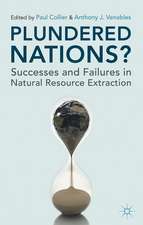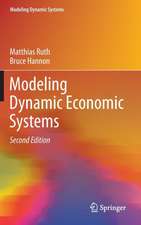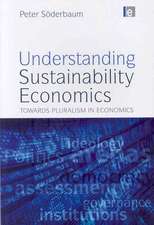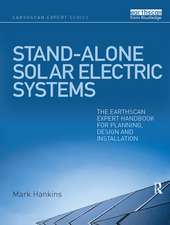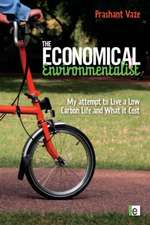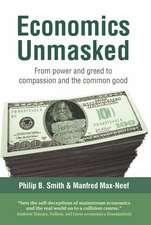Quantitative Eco-nomics: How sustainable are our economies?
Autor Peter Bartelmusen Limba Engleză Paperback – 21 oct 2010
This thought-provoking text raises doubts, however, about the measurability of sustainable development. Has the paradigm run its course? The answer is a guarded ‘yes’ – guarded because the concept still carries considerable environmental goodwill. At the same time the opaque concept fosters contradictory policy advice, or worse, inaction. Do we need zero- or accelerated economic growth? Should we reduce conspicuous consumption or enjoy spending as we see fit? Will rules and regulation or adjusted markets prevent environmental disaster?
| Toate formatele și edițiile | Preț | Express |
|---|---|---|
| Paperback (1) | 643.48 lei 6-8 săpt. | |
| SPRINGER NETHERLANDS – 21 oct 2010 | 643.48 lei 6-8 săpt. | |
| Hardback (1) | 653.98 lei 6-8 săpt. | |
| SPRINGER NETHERLANDS – 9 mai 2008 | 653.98 lei 6-8 săpt. |
Preț: 643.48 lei
Preț vechi: 757.04 lei
-15% Nou
Puncte Express: 965
Preț estimativ în valută:
123.17€ • 133.83$ • 103.53£
123.17€ • 133.83$ • 103.53£
Carte tipărită la comandă
Livrare economică 21 aprilie-05 mai
Preluare comenzi: 021 569.72.76
Specificații
ISBN-13: 9789048177783
ISBN-10: 9048177782
Pagini: 360
Ilustrații: XXX, 329 p.
Dimensiuni: 155 x 235 x 22 mm
Greutate: 0.5 kg
Ediția:Softcover reprint of hardcover 1st ed. 2008
Editura: SPRINGER NETHERLANDS
Colecția Springer
Locul publicării:Dordrecht, Netherlands
ISBN-10: 9048177782
Pagini: 360
Ilustrații: XXX, 329 p.
Dimensiuni: 155 x 235 x 22 mm
Greutate: 0.5 kg
Ediția:Softcover reprint of hardcover 1st ed. 2008
Editura: SPRINGER NETHERLANDS
Colecția Springer
Locul publicării:Dordrecht, Netherlands
Public țintă
ResearchCuprins
Part I: Questions, Questions, Questions.- 1. What on Earth is wrong?- 1:1 Paradise lost.- 1:2 Environmental doomsday and international reaction.- 1:3 Reaching the limits?- 2. What’s economics got to do with it?- 2:1 Economics out of sync?- 2:2 Schools of eco-nomic thought.- 2:3 Economic sustainability: maintaining capital and welfare.- 2:4 Ecological sustainability: dematerialisation.- 3. Sustainable development – blueprint or fig Leaf?- 3:1 What is development?- 3:2 Towards an operational definition of sustainable development.- 3:3 Normative economics for sustainable development?- Part II: Assessing the Physical Base of the Economy.- 4. Statistics and indicators.- 4:1 Statistical frameworks.- 4:2 From statistics to indicators ‘for’ sustainable development.- 4:3 Global warming: the indicator ‘of’ (non)sustainable development?- 5. Aggregation: From indicators to indices.- 5:1 Aggregation methods.- 5:2 Indices of environmental sustainability and sustainable development.- 5:3 Critique: towards a ‘balanced’ approach.- 6. Energy and material flow accounting.- 6:1 Rationale: social metabolism and environmental sustainability.- 6:2 Energy accounting.- 6:3 Material flow accounting.- Part III: Greening the Economic Accounts.- 7. Linking the physical and monetary accounts.- 7:1 Measures of economic welfare and wealth.- 7:2 Extending the national accounts: incorporating nature’s assets.- 7:3 Hybrid accounts: expanding the production boundary.- 8. SEEA – the System for Integrated Environmental and Economic Accounting.- 8:1 Pricing the priceless.- 8:2 SEEA objectives, structure and indicators.- 8:3 Case studies.- 8:4 SEEA revision.- 9. Corporate accounting: accounting for accountability.- 9:1 From accountability to accounting.- 9:2 From accounting to management.- Part IV: Analysis – Modelling Sustainability.- 10. Diagnosis: has the economy behaved sustainably?- 10:1 Welfaresecured? Dematerialised? Capital maintained?- 10:2 What are the causes? Structural analysis of environmental impact.- 11. Prediction: will economic growth be sustainable?- 11:1 Econometrics: the Environmental Kuznets Curve Hypothesis.- 11:2 Simulation of non-sustainability: the Limits-to-Growth model.- 12. Policy analysis: can we make growth sustainable?- 12:1 Environmental policy measures in general equilibrium and input-output analysis.- 12:2 Environmental constraints and optimality – a linear programming approach.- 12:3 Dynamic analysis: optimality and sustainability of economic growth.- Part V: Strategic Outlook.- 13. Strategies: tackling the limits to growth.- 13:1 Ignoring the limits: muddling through.- 13:2 Complying with limits: curbing economic activity.- 13:3 Pushing the limits: eco-efficiency.- 13:4 Adopting limits: sufficiency, corporate social responsibility, environmental ethics.- 14. Globalisation and global governance.- 14:1 Sustainability effects of globalisation.- 14:2 Global governance for sustainable development.- 15. Questions, questions, questions – and some answers.- 15:1 What’s the problem?- 15:2 What’s economics got to do with it?- 15:3 How bad is it?- 15:4 What can be done?- 15:5 Some non-conclusive answers.- Annexes.- I. Market failure and environmental cost internalisation – a primer.- II. Economic rent and natural resource depletion.- III. SEEA Germany – a pilot case study.- References.- Index.- Colour Plates.
Textul de pe ultima copertă
Fuzzy vision, anecdotal evidence, media hype and rhetoric characterise the debate of environment and economy. At the same time the cornucopian concept of sustainable development enjoys undiminished popularity. Hardly any publication or proclamation on the environment can resist summoning the paradigm.
"Quantitative Eco-nomics" cuts through the fog of vision and advocacy by comparing and applying new quantitative tools of both environmental and ecological economics. Environmental accounts and empirical analyses provide operational concepts and measures of the sustainability of economic performance and growth. They facilitate rational and compatible environmental and economic policies.
This thought-provoking text raises doubts, however, about the measurability of sustainable development. Has the paradigm run its course? The answer is a guarded ‘yes’ – guarded because the concept still carries considerable environmental goodwill. At the same time the opaque concept fosters contradictory policy advice, or worse, inaction. Do we need zero- or accelerated economic growth? Should we reduce conspicuous consumption or enjoy spending as we see fit? Will rules and regulation or adjusted markets prevent environmental disaster?
"Quantitative Eco-nomics" does not brush over open questions, but puts them in perspective. It ends as it began with "questions, questions, questions". The objective is to foster a dialogue between pessimistic environmentalists and more optimistic economists, and furthermore to bring these concepts and tools to the attention of classrooms, boardrooms and offices.
‘This is a book that must be on the desk of every policy maker, public or private and should be studied by any university student.’
Mostafa K. Tolba, President, International Center for Environment and Development (ICED) and former Executive Director (1974 – 1992), UnitedNations Environment Programme (UNEP)
‘This is an important book and should be read by everybody who wants to understand the crucial challenge of environmental sustainability. It is a timely and extremely relevant contribution.’
Robert Repetto, Professor in the Practice of Economics and Sustainable Development, Yale University
‘[This] book is an extremely valuable contribution to the still evolving basic literature on the relationship between economy and environment.’
Bedrich Moldan, Professor at Charles University of Prague Environment Centre, Senator of the Czech Parliament
‘…The time has come for different countries to reach a quick consensus on sustainable development…This book will serve as a bridge, facilitating the communication between mainstream economists, ecological economists, environmental researchers, government officials, entrepreneurs and ordinary people.’
Jianguo Qi, Professor at the Institute of Quantitative and Technical Economics, Chinese Academy of Social Sciences
"Quantitative Eco-nomics" cuts through the fog of vision and advocacy by comparing and applying new quantitative tools of both environmental and ecological economics. Environmental accounts and empirical analyses provide operational concepts and measures of the sustainability of economic performance and growth. They facilitate rational and compatible environmental and economic policies.
This thought-provoking text raises doubts, however, about the measurability of sustainable development. Has the paradigm run its course? The answer is a guarded ‘yes’ – guarded because the concept still carries considerable environmental goodwill. At the same time the opaque concept fosters contradictory policy advice, or worse, inaction. Do we need zero- or accelerated economic growth? Should we reduce conspicuous consumption or enjoy spending as we see fit? Will rules and regulation or adjusted markets prevent environmental disaster?
"Quantitative Eco-nomics" does not brush over open questions, but puts them in perspective. It ends as it began with "questions, questions, questions". The objective is to foster a dialogue between pessimistic environmentalists and more optimistic economists, and furthermore to bring these concepts and tools to the attention of classrooms, boardrooms and offices.
‘This is a book that must be on the desk of every policy maker, public or private and should be studied by any university student.’
Mostafa K. Tolba, President, International Center for Environment and Development (ICED) and former Executive Director (1974 – 1992), UnitedNations Environment Programme (UNEP)
‘This is an important book and should be read by everybody who wants to understand the crucial challenge of environmental sustainability. It is a timely and extremely relevant contribution.’
Robert Repetto, Professor in the Practice of Economics and Sustainable Development, Yale University
‘[This] book is an extremely valuable contribution to the still evolving basic literature on the relationship between economy and environment.’
Bedrich Moldan, Professor at Charles University of Prague Environment Centre, Senator of the Czech Parliament
‘…The time has come for different countries to reach a quick consensus on sustainable development…This book will serve as a bridge, facilitating the communication between mainstream economists, ecological economists, environmental researchers, government officials, entrepreneurs and ordinary people.’
Jianguo Qi, Professor at the Institute of Quantitative and Technical Economics, Chinese Academy of Social Sciences
Caracteristici
Applies new quantitative tools of both environmental and ecological economics Provides operational concepts and measures of the sustainability of economic performance by making use of environmental accounts and empirical analyses Further Reading” sections at the end of each chapter 16 full colour plates




